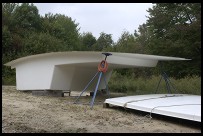
Nikon D1x
by Philip Greenspun; created 2001
Site Home : Photography : Nikon D1x
If you can handle the 3 lb. weight and the $5000 price, the Nikon D1x is the best handheld digital camera on the market. You never wait for this camera. Switch the camera on, press the shutter release, and you've got your photo. This entire process takes less than one second, which is about 9 seconds shorter than, say, on a Nikon 775 point-and-shoot digital. If the camera is already switched on but asleep, the wake-up time is about 0.2 seconds. If the camera is switched on and you've already focussed, the shutter lag is probably down near the 0.050 second mark of a standard film SLR, i.e., just enough time for the mirror to flip up.
The D1x uses its on-board memory intelligently. Suppose that you've just taken a portrait. The 6 megapixels (1960x3008) have been captured by the camera but not written out to the flash card or Microdrive. Your subject's expression changes subtly. You press the shutter release again. Instantly the Nikon records another images and adds it to the in-camera memory buffer. You can keep doing this up to 9 times and only then will you have to wait for the camera to finish writing some images to the flash card.
This review is illustrated primarily with some images of a boat deck and hull being mated in Eliot, Maine:
The Nikon D1x is built to accept the complete line of Nikon F-mount lenses. It was built from an F100 body but has the weight and bulk of the Nikon F5. The camera's 15.6x23.7mm CCD image sensor is smaller than the standard 24x36mm frame of a 35mm camera. Thus the image that you see in the viewfinder and on the flash card is magnified 1.5X, i.e., a 50mm normal lens becomes an 75mm short portrait lens, the popular Nikon 17-35/2.8L zoom becomes 25-52mm, and a 300/2.8 supertelephoto becomes a 450mm lens.
The viewfinder is wonderful for an eyeglass wearer, with a lot of eye relief in the Nikon "high-eyepoint" tradition. You'll be able to see the entire image and the LCD display just underneath. The rear LCD is anti-reflection coated and reasonably readable in bright light (though you should just throw out the protective translucent cover that Nikon provides; if you really want a cover get a "Hoodman").
Sensor speeds from ISO 125 to 3200 are available, but sadly ISO 1600 and ISO 3200 cannot be selected with the "ISO" switch and main dial. You will need to wade through the custom function menus in order to enable what Nikon calls "ISO boost". If Nikon wanted to warn photographers about the extra noise entailed at these high speeds, they should have done it with a "warning: noise" note in the rear LCD, not a painful user interface.
The images are 8 bits deep when producing standard JPEGs (2.8 MB each), 12 bits deep when storing RAW images (around 4 MB each). Image quality is superb; it is easy to make high quality 16x24 prints.
With standard 8-bit JPEGs, the contrast range isn't large enough to record detail in both a black and white dog, even on a cloudy day with flat light:
Using RAW mode and some PhotoShop manipulation, one can do a bit better, but it still isn't very good. This is a difficult process because most PhotoShop operations only work with 8-bit files. The program is advertised to handle 16-bit TIFFs but mostly all you can do with these files is bash them down to 8 bits. Here are a couple of photos that started as RAW:
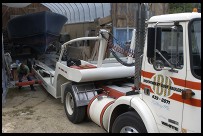 The Nikon D1x is a
"two-dial" camera, fundamentally. To my taste, these are not positioned as well
as on the Canon EOS bodies, but it is still much better than a "one-dial" user
interface. One dial is on the top front of the camera, just underneath the
shutter release. The other is on the top rear of the body, just behind the
top-deck LCD. Even photographers who use the Nikon system daily complain about
the location of these dials.
The Nikon D1x is a
"two-dial" camera, fundamentally. To my taste, these are not positioned as well
as on the Canon EOS bodies, but it is still much better than a "one-dial" user
interface. One dial is on the top front of the camera, just underneath the
shutter release. The other is on the top rear of the body, just behind the
top-deck LCD. Even photographers who use the Nikon system daily complain about
the location of these dials.
With a custom function, you can set the dials to operate as on a Canon EOS. In aperture-priority exposure mode, for example, one dial will adjust the lens aperture and the other will add or subtract exposure compensation.
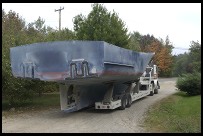 An additional
four-way paddle switch on the rear of the body, more or less where Canon's second
dial is positioned, is used for picking an autofocus sensor or navigating the
menus.
An additional
four-way paddle switch on the rear of the body, more or less where Canon's second
dial is positioned, is used for picking an autofocus sensor or navigating the
menus.
A final control option is available with a custom function: the lens aperture ring. If you prefer to use your left hand to set the aperture, you can have disable the camera dial control and simply use the aperture rings provided on most Nikon lenses.
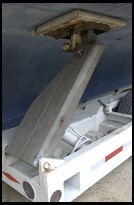 The D1x need not be modal.
The camera has a dreaded "playback" setting but you don't have to use it to
review your photos. Press the "monitor" button and you can view your most recent
creations, cycle among your photos, cycle among histogram versus info text versus
straight viewing, etc, all by using the rear paddle. If a great photo opportunity
presents itself while you're reviewing, simply press the shutter release and
0.050 seconds later, you've got your photo. You never wait for this
camera.
The D1x need not be modal.
The camera has a dreaded "playback" setting but you don't have to use it to
review your photos. Press the "monitor" button and you can view your most recent
creations, cycle among your photos, cycle among histogram versus info text versus
straight viewing, etc, all by using the rear paddle. If a great photo opportunity
presents itself while you're reviewing, simply press the shutter release and
0.050 seconds later, you've got your photo. You never wait for this
camera.
Setting custom functions is easy. All 36 are presented in plain English (or French or German or Japanese) text on the rear LCD. You will not need to carry around the owner's manual or a crib sheet. There are four banks of custom settings so you could use one for "indoor sports" (ISO boost to 1600), one for "tripod landscapes" (self-timer delay down to 2 seconds, mirror pre-release), etc. One very welcome custom function is disables the shutter if there is no flash card in place. I once watched a friend spend 20 minutes taking pictures of his kid at the beach with a Canon D30. He exposed about 30 images before realizing that the flash card was in his pocket rather than in the camera. You can't screw yourself in this way with the Nikon D1x.
A dedicated depth-of-field preview button to the right of the lensmount is convenient but makes the Mother of All Clicking Noises when engaged.
The battery compartment contains a second shutter release for vertical photography, a duplicate main control dial just underneath, and a duplicate AF-ON button. It is easy and natural to shift between horizontal and vertical photography.
Bottom line: the user interface is complex but logical and not more complex than necessary given all the power of the camera.
The Nikon D1x has five autofocus sensors. The photographer chooses or the sensor or the camera can be set to pick the sensor over the closest object. This works well for carefully composed pictures or a portrait session. But if you've been spoiled by the massive AF sensor grid of a Canon EOS-3 or EOS-1V, you won't be very happy with the 5-point Nikon system. That said, autofocus is fast and precise with both AF-S and older Nikon lenses.
The D1x facilitates simultaneous use of manual and auto focus with AF-S lenses. Using Custom Function 4, you can shift autofocus from the shutter release to the AF-ON button on the rear of the body, which falls very naturally underneath your right thumb. If you have a lens with a "silent wave" motor (Nikon's answer to Canon USM), you can leave the lens in AF mode for AF or MF. When you want to focus, turn the ring on the lens or push the button under your thumb. You make a conscious decision. If your subject stays at the same distance and you don't feel the need to refocus, you need not. If CF 4 is set, the camera will never run off wildly and unexpectedly to hunt for focus.
Unlike competitors such as the Canon EOS D30, the Nikon D1x does not include an on-camera flash. If you're creating 8-bits-per-color (24-bit total) JPEG images it is very easy to exceed the contrast range of any digital camera. So you should probably take advantage of the brilliantly successful Nikon balanced fill-flash system and an SB-28X speedlight.
The full range of Nikon off-camera flash cords and flash control systems work with the D1x. Sadly, you don't get even basic through-the-lens flash exposure metering with older flashes because the D1x cannot measure flash exposure "off-the-film". With the newest flashes such as the SB-28X the camera judges flash exposure with a pre-flash the instant before exposure.
The Nikon D1x has a single CompactFlash card slot that accepts IBM Microdrives or standard flash memory cards. The ideal companion for this camera is a Lexar 512 MB card. This will hold roughly 180 full-resolution high-quality JPEGs or 128 RAW images. Lexar cards tend to offer among the very fastest writing speeds of any CompactFlash devices.
Nikon supplies a custom 7.2V NiMH battery pack. This is prodigiously heavy and prodigiously powerful, good for a full day of photography. It would be nicer if the camera were powered by a Lith-ion battery like a modern laptop or Canon digital camera. The charger is monstrously bulky and yet the battery does not sit in the charger when charging. You set the charger up on a table top, pull the battery from the camera, and plug a cable from the charger into the battery, which also sits on the table top.
Power for the clock is supplied by a separate internal lithium battery, good for ten years.
Available separately for around $200, the Nikon Capture software lets you control and operate the D1x from any personal computer equipped with an IEEE-1394 FireWire interface. You can see and set all the custom functions with three dialog boxes. You can verify the voltage level in the main and clock batteries. You can set the camera's exposure mode, exposure compensation, and take a single photo or request a time-lapse sequence. This is the ultimate tool for a studio photographer using the D1x on a boom and the ultimate toy for photographers who love to sit in front of their computers.
The bundled software story is not an entirely happy one. In order to transfer images from the flash card to your computer, you need to use a separate application: Nikon View. In order to view thumbnails or rotate vertically-exposed images into correct orientation, you'll need to find and use yet a third program (Nikon does not supply anything to do this; I find Canon Zoom Browser EX, bundled with Canon digital cameras, to be the fastest way of correctly orienting images).
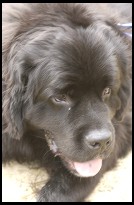 The most
serious problem with the D1x is that it lacks a sensor to tell when it is being
held vertically. This means that all of your vertical images will come out as
incorrectly oriented image files and you'll have to manually reorient them on a
computer.
The most
serious problem with the D1x is that it lacks a sensor to tell when it is being
held vertically. This means that all of your vertical images will come out as
incorrectly oriented image files and you'll have to manually reorient them on a
computer.
You'll eventually get dust on the sensor, as with any interchangeable lens digital SLR. But you won't be able to lock up the mirror for cleaning unless you have purchased and are carrying an EH-4 AC adapter ($100 if you can find one; often out of stock).
Image at right: this uncompensated (and overexposed) photograph of a Newfoundland dog shows that the Nikon D1x's 1000-element color matrix meter is not equal to the task of handling black objects. There is no substitute for a thinking photographer!
Canon has been showing its EOS-1D body in Japan. This offers lower resolution than the D1x, only 4.5 megapixels (1662x2496 pixels). With this professional camera, Canon has abandoned the CMOS sensor of its consumer D30 body. The EOS-1D sensor is a standard CCD. Canon says that it did this to achieve an 8 frames-per-second capture rate. One nice thing about the sensor is that it is huge, implying a lens focal length multiplier of only 1.3 as opposed to 1.5 or 1.6 for most other digital SLRs. Considering that this camera comes about six months later than the D1x, Canon's achievement can only be described as "lame". The primary group of people who will be happier with the EOS-1D over the D1x are sports photographers. The Canon body has 45 autofocus sensors (compare to 5 on the D1x and D1H). The Canon body has that 8 fps capture rate (compare to 3 fps on the D1x and 5 fps on the D1H). The Canon body may also be superior for wide angle enthusiasts, since the 1.3 magnification rate means that the 17mm end of a 17-35 zoom is still fairly wide. Finally the Canon body, in the best Canon tradition, offers awesome environmental sealing. You can take your EOS-1D out in the rain with confidence. The D1x is well-sealed but the EOS-1D should be a lot better, especially when used with the rubber-gasketed L-series lenses.
If you have a hard time swallowing the D1x's price, don't blunder into buying a Nikon D1 unless you've read my review of the D1 and are fully prepared for the horrors of its user interface. A better choice for many Nikon lens system owners is probably the Fuji S1. If you want a digital single-lens reflex that is reasonably inexpensive and that will free you from the nightmare of dust on the sensor, consider the Olympus E10.
Sports photographers with big Nikon lens systems should look at the Nikon D1H, which has lower resolution than the D1x but higher frame rate and a large in-camera memory for continuous photography.
The images on this page were taken with the Nikon 28-70/2.8 AF-S lens and the
Nikon 20-35/2.8 D lens. All of the equipment was borrowed from a friend.
Text and photos copyright 2001 Philip Greenspun.